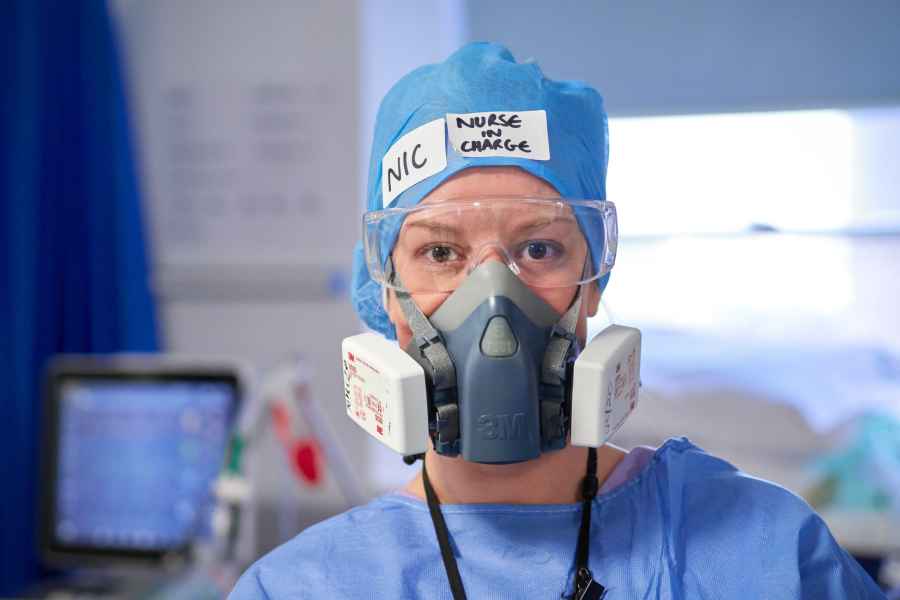When not taking photographs, usually somewhere on the side of a mountain, I have spent much of the past 15 years as a consultant in intensive care medicine at the Royal Gwent Hospital in Newport, Wales. Medicine and photography have a surprising number of things in common. Both blend art and science, and the ability to see clearly is as fundamental for success in medicine as it is in photography. Throughout history, doctors have used visual clues to aid in diagnosis: observing the facial expression and altered gait of a patient might point a neurologist to a diagnosis of Parkinson’s Disease while a subtle skin rash may be the first harbinger of potentially fatal meningitis and sepsis. In medicine, just as in photography, if you do not look with an open mind you will only see what you are expecting to see and risk missing what is important.
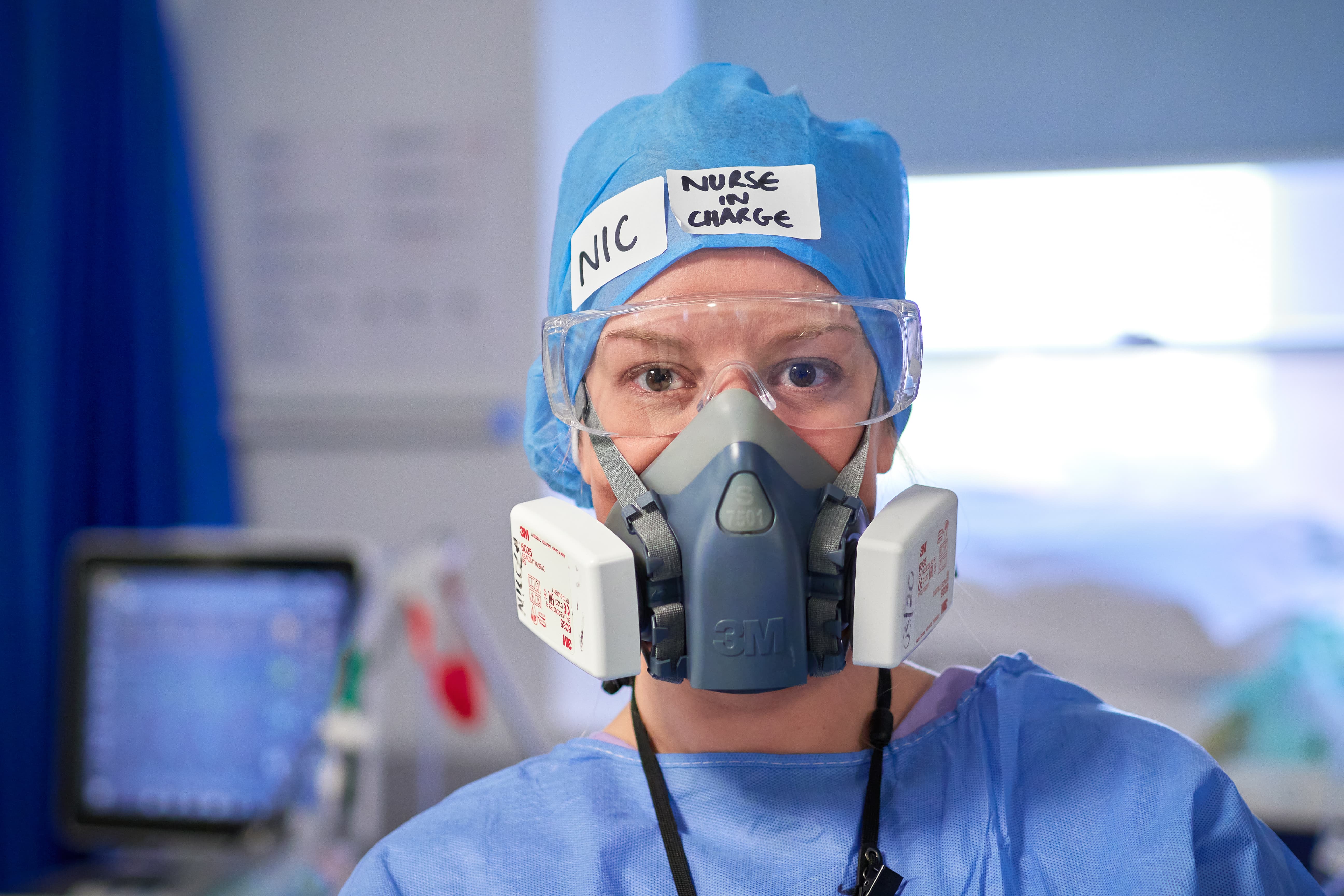
ICU Sister Nicola Rogers wearing the reusable face masks that became increasingly common during the first wave.
Unavoidably, my life at the hospital this year has been dominated by COVID-19. It already feels as though it was in another lifetime, but a year ago the world had never heard of the virus that has so radically reshaped the way in which we live, not only in the necessary measures to contain it so that our National Health Service is not overwhelmed, but also through the growing mistrust, misinformation and division within our nation that the pandemic, and our politicians in Westminster, have allowed to flourish.
The Royal Gwent serves the socially deprived former South Wales coal-mining communities of Caerphilly, Torfaen and Blaneau Gwent and has fewer intensive care beds for the size of the population that it serves than anywhere in the UK. It was against this background of social deprivation and historic under-resourcing that the Gwent would be confronted with one of the highest infection rates outside of London that by mid-April saw our intensive care unit (ICU) running close to 300% of its normal capacity and brought us to within days of running out of crucial drugs.
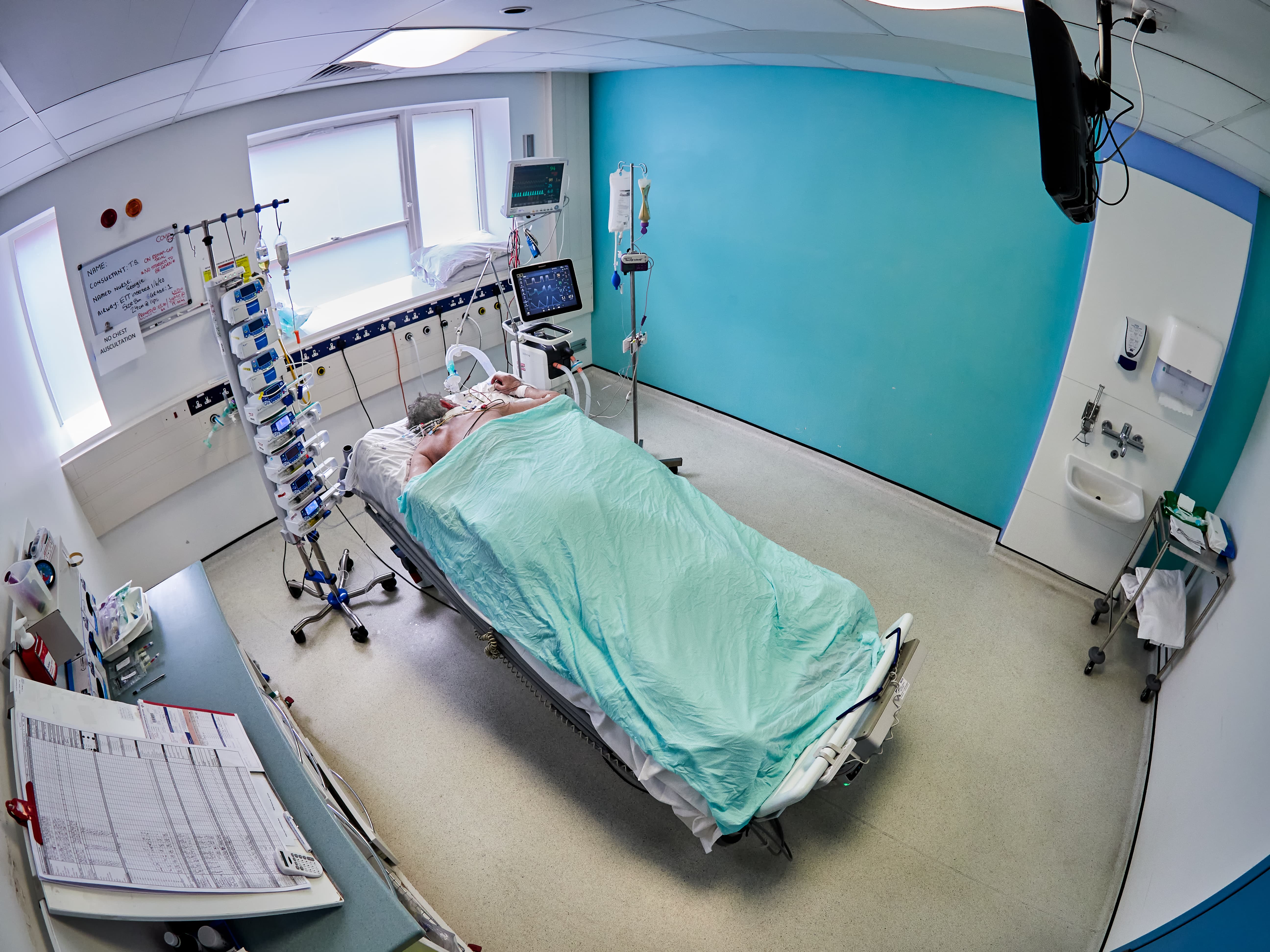
Supsended between life and death a patient with severe respiratory failure from COVID-19 is ventilated in the prone position.
In early March 2020 as the Gwent began to prepare for the impact of COVID-19 it was apparent that the NHS, founded in 1948 by Aneurin Bevan whose former constituency lies within our Health Board, was facing the biggest single challenge in its history. It was also obvious that what was about to happen had to be documented. With a ban on all visitors to the hospital, including journalists – it would have been unjustifiable to allow a photographer into the hospital while denying families the right to visit dying relatives – I found myself picking up my camera to record the impact of the pandemic on the lives of my colleagues and the patients we were caring for in ICU.
In recent months, intensive care has received a level of media coverage unknown during its short history, but I was not to be a journalist parachuted into a hospital for a few days – but rather the photographs that I would take in the weeks and months ahead, at the ends of shifts or on my days off, would give a unique perspective on what it was like to work in intensive care throughout the first wave of the COVID-19 pandemic of 2020.
Having used Olympus cameras since converting to digital capture nearly 20 years ago I was fortunate that Olympus UK readily agreed to support the project with the loan of an OM-D E-M5 Mark III camera, a 25mm f1.2 Pro lens and 45mm f1.8 lens that were able to stay permanently in the red zone of ICU where the highest level of personal protective equipment (PPE) was worn. Although when I am in the mountains I invariably use zooms,
I was keen to use fast primes and shoot as much as possible using existing light. Intensive care units are stark, bright and clinical places and I do not recognise some of the dark and moody pictures, with excessive mid-tone contrast, that have come from ICUs in recent months.
For similar reasons I abandoned my initial plans to produce the images in black & white. Looking at the world through a viewfinder brings a new perspective to the familiar, and after the first few days of processing images I realised that the environment in which I have worked for so many years is indeed monochrome but a blue and white monochrome. As far as was practicable I wanted my images to reflect simply and accurately the reality of ICU which is a dramatic enough environment without the need to create further visual drama in post-processing.
Operating challenges
Taking photographs in PPE proved challenging. Operating a camera in gloves is very familiar to me, even something as small as the E-M5 which has been my go-to camera for ski touring over many years, but trying to control a camera while wearing the reading glasses necessary for work and a full-face visor was not easy. Even using the rear LCD screen could be frustratingly difficult with reflections bouncing around the visor from the bright overhead lights.
Eventually I acquired some industrial PPE varifocal glasses which meant I could dispense with the visor and use the camera’s electronic viewfinder although even this could be challenging and it was crucial to have a clear idea of the shot’s composition in your mind before ever looking through the viewfinder. Eye autofocus was indispensable when taking portraits. Patients who were identifiable in pictures were approached once they were recovering, the purpose behind the photographs was explained to them and they were asked to sign a release form.
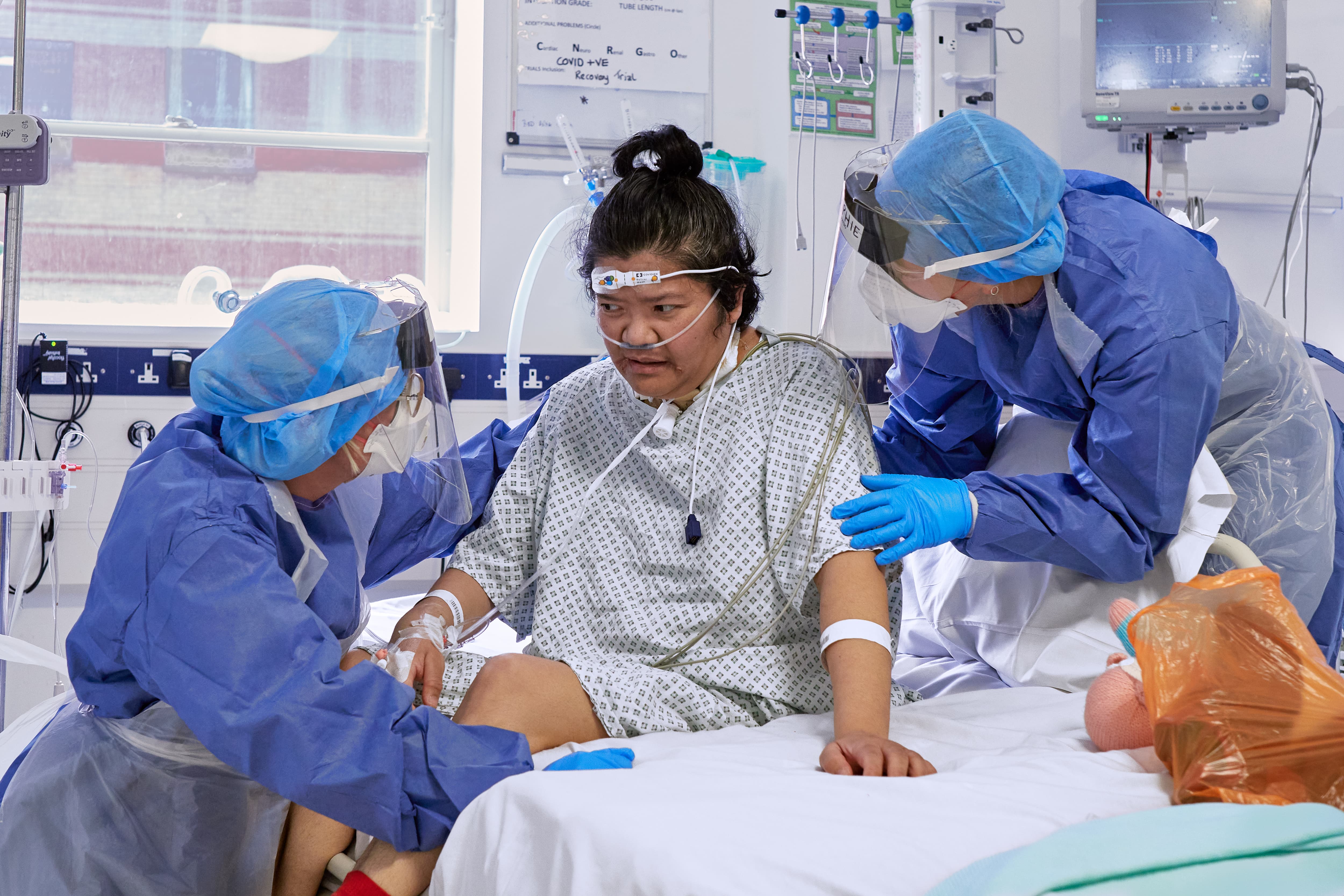
Physiotherapists Sara Biggs and Sophie Hinds encourage A and E Staff Nurse Cindy Sulit to take her first steps after 23 days in intensive care.
With so much that I could photograph, I decided early on that documenting a typical patient’s journey through ICU from admission to discharge and their ongoing rehabilitation on the ward would form the principal framework for the project. Care in ICU is delivered by a large multi-disciplinary team and photographing the members of this team and recording their experiences became the next layer of the project. The obvious members beyond the doctors and nurses, would be physiotherapists, dieticians, pharmacists, speech and language therapists, occupational therapists and psychologists, but there is an army of people in the background whose stories are rarely heard and who frequently get paid very little.
One such person would be Greg (below) who I met as I parked my van near to the pressurised bulk oxygen store that supplies the hospital with this crucial gas. Several hospitals came close to running out of oxygen in early April with at least one declaring a major incident as supplies fell to critically low levels. As oxygen leaves the store it draws heat from the surrounding air resulting in a heavy frosting of the pipes. If too much frost builds up, the pipes become dangerously heavy and could bend and crack.
Every morning, unbeknown to most people in the hospital, Greg or one of his colleagues drive down to the oxygen store and hose the frost from the pipes thus ensuring an ongoing supply of oxygen to the hospital. As the weeks passed it became increasingly important for me to tell the story of people like Greg, the unknown and unrecognised members of staff without whom the whole system would fall apart.
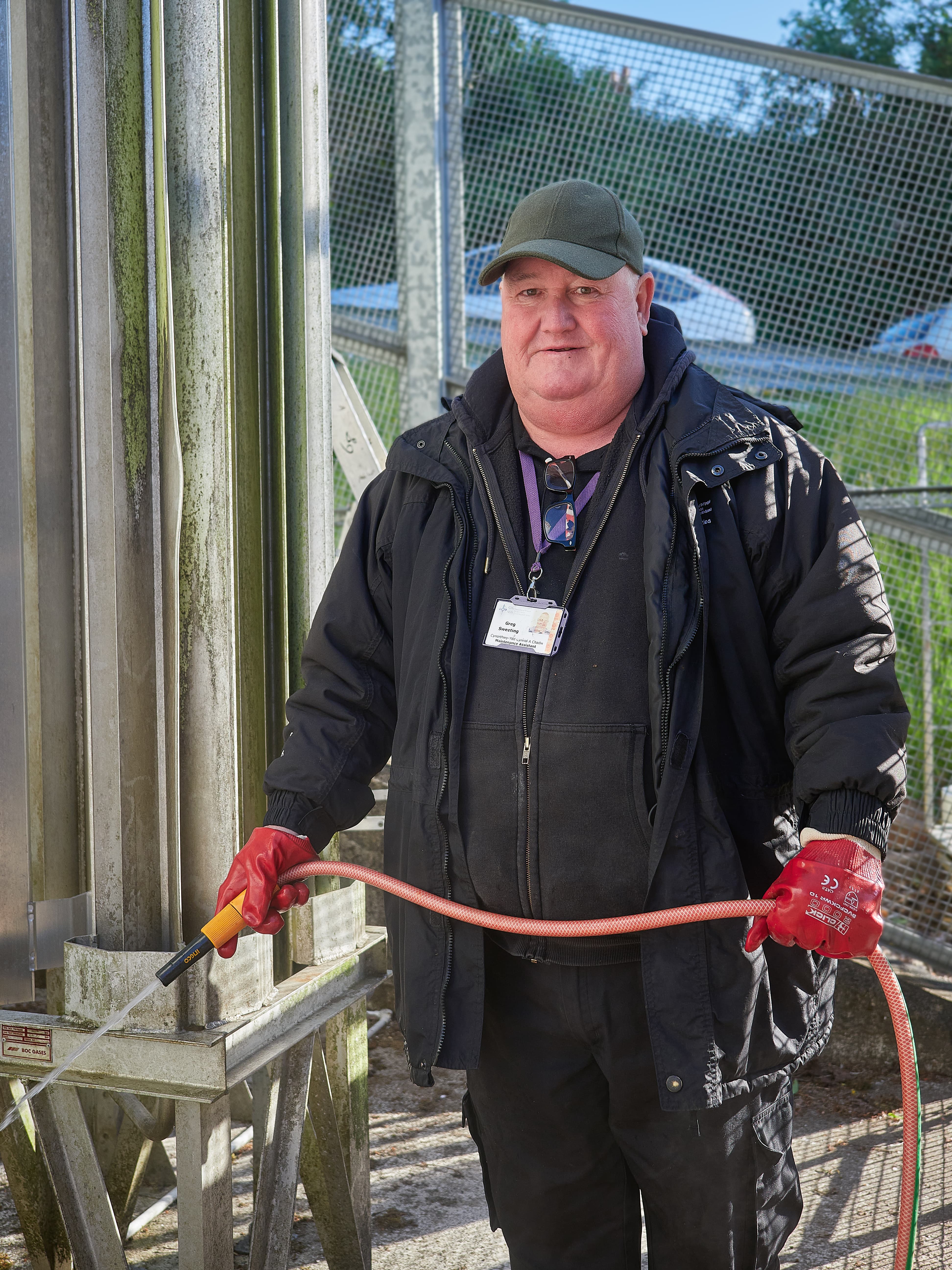
Greg Sweeting, Maintenance Assistant. Most mornings he hoses the thick layer of ice that builds up on the piping from the oxygen tanks that supply the hospital.
For those unfamiliar with working there, intensive care can be a profoundly disturbing and stressful place. As patient numbers increased far beyond anything previously seen we were only able to cope because of the extraordinary and, yes, genuinely heroic efforts of staff from other specialities and departments for whom ICU was an alien and intimidating environment but who, nevertheless, came to our aid. For this generosity many paid a high psychological and emotional price. At the height of the first wave when we placed beds between the normal bed spaces and created a number of temporary ICUs within the hospital many staff, including experienced ICU nurses, admitted to finding the experience overwhelming and told of returning home at the end of their shifts unable to stop crying.

Recovery nurse Alex Owen who normally works in orthopaedic theatres and who volunteered to work in ICU, at the end of a long shift in PPE.
It is testimony to all who worked tirelessly in ICU at the Gwent that the mortality rate from COVID-19 was comparable with the best in the UK. Nevertheless, it is an inescapable fact that around one third of patients admitted to ICU died. To photograph only the staff and those patients who survived would be a betrayal of the truth and a disservice to the memory of those patients who died and their families who mourn them. As I talked to my colleagues about how to sensitively and respectfully photograph this sobering aspect of COVID-19 their response was overwhelmingly one of support and all agreed that this was part of the story of the pandemic that must be told.
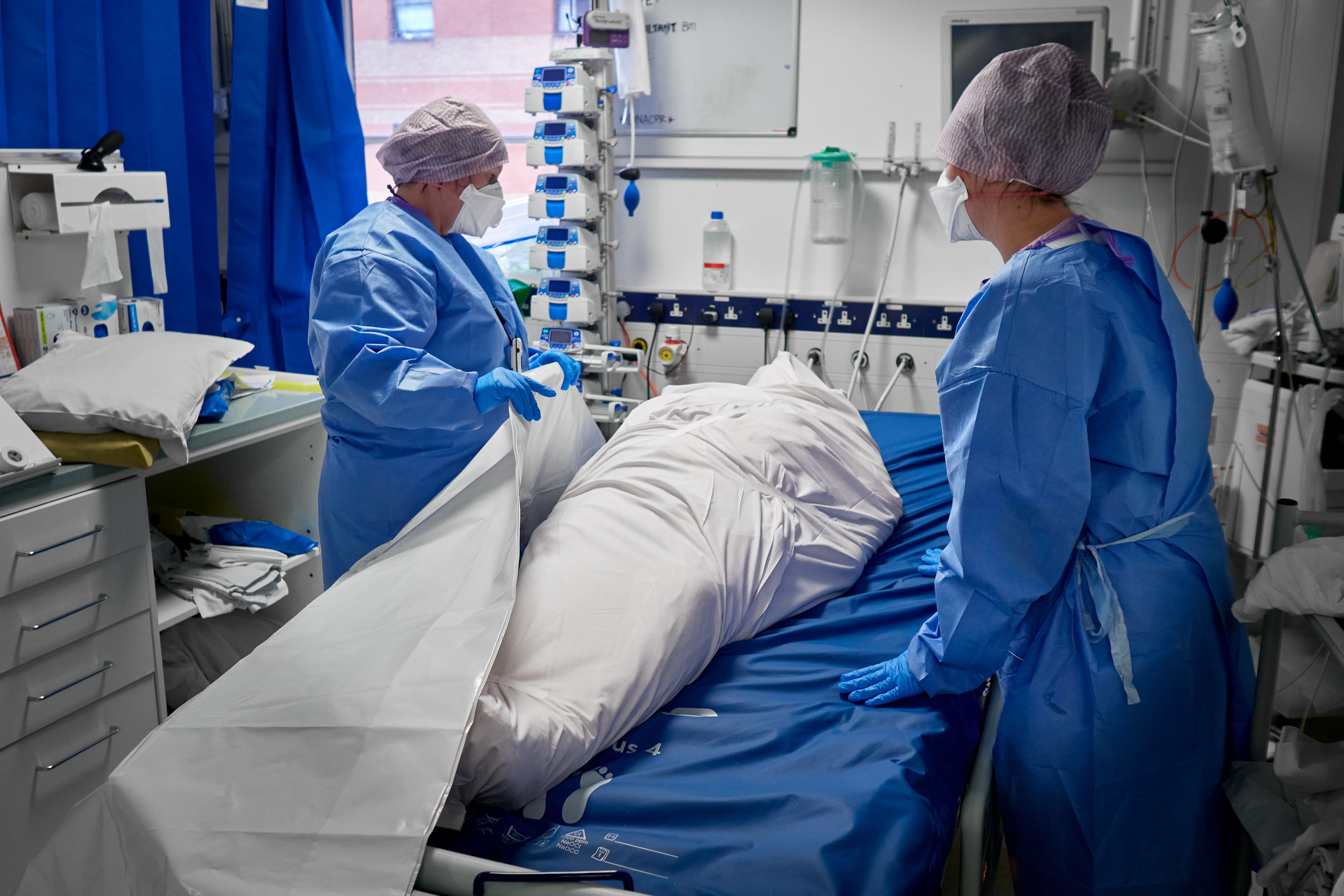
Placing the body of a deceased patient in a body bag. Perhaps the hardest of all jobs that a nurse is required to do but one that is always carried out with the utmost respect and dignity.
To work in intensive care is to be confronted with death on an almost daily basis, nevertheless the photographs that I took of a deceased patient’s body being wrapped in a shroud and placed in a body bag before being transported to the mortuary were the most difficult for me and yet perhaps also some of the most important. To those who might accuse me of gratuitous sensationalism or a lack of sensitivity my response is simple: death was an ever-present reality throughout the first wave of the pandemic and not one doctor or nurse who has seen the pictures has questioned the acceptability of taking them or the importance of them being shown.
Truth
In trying to find ways to document truthfully the impact that COVID-19 has had on the NHS I spent a lot of my spare time talking to our mortuary staff whose experience merits being told in its own right. They asked me to photograph the temporary mortuary built to accommodate the almost unimaginable increase in deaths within the community that they were required to deal with and which they managed with extraordinary professionalism and care. Ironically, of all the photographs that I took during the spring and summer of 2020 I think that those images of that vast tented and refrigerated structure built to accommodate 480 bodies and that I visited at the beginning of June shortly after the last body had left, bring home most powerfully the brutal lethality of COVID-19 and the ongoing threat that it continues to pose to our nation.

The temporary mortuary constructed at Llanfrechfa Grange to accommodate 480 bodies brings home the terrifying leathality of the COVID-19 virus.
My COVID camera has been relatively quiet for the past couple of months but with case numbers predictably rising again it will not be long before I find myself photographing in PPE again. Recording the most challenging and exhausting months of my medical career has been a blessing and a curse but something that had to be done. Selecting and processing the hundreds of images that I took has meant that even in my time away from the hospital it has been impossible to escape work, but at the same time processing the images has allowed me to process and reflect upon my own experience of the pandemic and to find the equilibrium and courage which will be so necessary if, as we expect, the winter see as big a spike in cases, if not bigger, than we experienced in the spring.
To practise as a doctor in intensive care medicine and to serve the patients in my care has been one of the greatest privileges of my life. Part of that privilege has been to work as a part of teams of remarkable colleagues. For all of the interest in my photographs on national television and in the press, plus all the talk of exhibitions and books, the greatest compliments have been to hear those colleagues say, ‘You have told our story.’ You can see more of Nick’s work, including non-COVID imagery, here.
Photography practicalities
* The project was fully supported by my employer, Aneurin Bevan University Health Board.
* Patients who were identifiable in photographs were approached once they were recovering on the ward. The project was explained to them and they were asked to sign a release form. Patients were universally supportive of the project and none refused to give their consent.
* The camera and lenses were stored in a tough waterproof stuff-sack which could be dipped in the antiseptic solution used to clean our clogs. This enabled me to transport the gear safely to other red zones such as the ward areas that had been converted to additional temporary ICUs.
* Images were written onto SanDisk Extreme SD cards which are waterproof and easily withstood being wiped down with an antiseptic wipe as I took them out of ICU. This was then repeated when I got them home for added safety prior to uploading them to my computer.
* Images were initially processed in CaptureOne, which is so much more effective at bringing the best out of Olympus raw files compared to other raw processors, before further editing such as dodging and burning in Photoshop.

